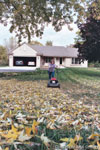Lady's Heart of the Home |
 Spring Starts in the Fall Spring Starts in the FallYes, now is the time to start thinking about spring. Preparing your lawn for winter dormancy also helps it get a good, quick start when the weather warms next spring. Getting Ready In the fall, as the days get shorter and temperatures dip into daytime averages of less than 50 degrees, grass begins to prepare for winter and the following spring. Shoot growth ceases, so all the carbohydrates produced and the nutrients taken up are stored in the shoots and roots. This storage helps the grass overcome the ravages of winter dormancy. For a long time, it was thought that when shoot growth stopped grass did not use nutrients. Present turf researchers, including Dr. Wayne Kussow of the University of Wisconsin -- Madison, now know that turf continues to use nutrients right up to the time that soil freezes. Healthy Roots Make Healthy Grass When your grass is deficient in nitrogen in the fall, carbohydrate production drops off. The result is weak grass that either does not survive the winter cold or, in most cases, survives but takes well into the next season to begin to look good. Why not start the turf looking good first thing in the spring? “Apply the full rate of a slow release nitrogen fertilizer so that it keeps the grass nice and green,” says Dr. Kussow. “This ensures maximum production of carbohydrates at this critical time of the year.” Apply this late fall fertilizer after turf has been cut the last time and is not growing. “An added advantage of this late season nitrogen application is that it promotes uptake of other nutrients, helping ensure good winter hardiness and rapid re-growth the next spring,” Dr. Kussow adds. Using a full rate of fertilizer allows roots to feed well into the dormant period. Two Applications for Great Results Turf professionals generally talk about two fall applications of fertilizer. The first is in the early fall, around Labor Day, when grass is still growing. Apply a full rate at this time to keep grass growing in the fall. This will maintain a dense turf that doesn’t allow weed seeds to make contact with soil and germinate before cold weather comes. The second fall application is called a dormant or early winter application. This full rate application is applied after grass has quit growing. Generally, this will be around Thanksgiving, depending on your location and the temperatures you are experiencing. Many golf course superintendents in northern areas use this technique to give their courses an early start the next spring. Just make sure you do not apply fertilizer to frozen ground, as it will encourage runoff into lakes and streams. Southern Grass -- A Special Case Southern grass types present a little different situation in the fall. It is very important to apply the fall application before grass is going dormant. This will cause the grass to try to grow when it should not. If it tries to grow, it will not survive the dormant season. Also, if you are overseeding rye grass for winter greening, wait until your southern grass is completely dormant before applying fertilizer to your lawn. Leaves According to master gardener Mike Archer of Milorganite, leaves come in two general shapes when they drop from trees -- flat and rounded. Maple leaves, for instance, are flat. They will lay flat on the lawn and, when it rains or snows, form a tight layer over the grass. This can smother grass. Rake these or mulch mow them to make sure your grass can breathe through the winter. Rounded leaves, such as those from oak trees, generally do not present this type of problem. However, if they are thick on your lawn, it is still best to rake them up or mulch mow them to maintain a healthy lawn. Some leaves, such as those from locust trees, are small. These generally are not problematic and do not need to be removed or mulched. Fall Mowing As always, keep you mower blade sharp. A sharp blade causes a clean cut on the grass leaf, which quickly heals. Dull blades shred the grass and cause a great deal of damage to lawns. In turn, this damage opens the door for disease. A few minutes sharpening your lawn mower blade is a good investment to a great lawn. Watering in the Fall Even though your lawn ceases growing for the winter, it still needs moisture to survive. Remember, your grass is not completely dormant until early winter. Plus, if you get dry winter winds with very low humidity, winter burn will damage patches of your lawn. Keep your lawn watered as you would in the summer, watering infrequently but deeply. Water to rooting depth of your grass, generally four to six inches. More Help If you have questions about the timing of fall fertilizer applications in your area, contact your local County Horticultural Extension Agent or call the Milorganite Help Line at (800) 304-6204. Courtesy of ARA Content
Please post your comments about this article on the
No right click ResourcesLinks are provided for your information and enjoyment. The links do not imply endorsement of the sites' products or advice. |